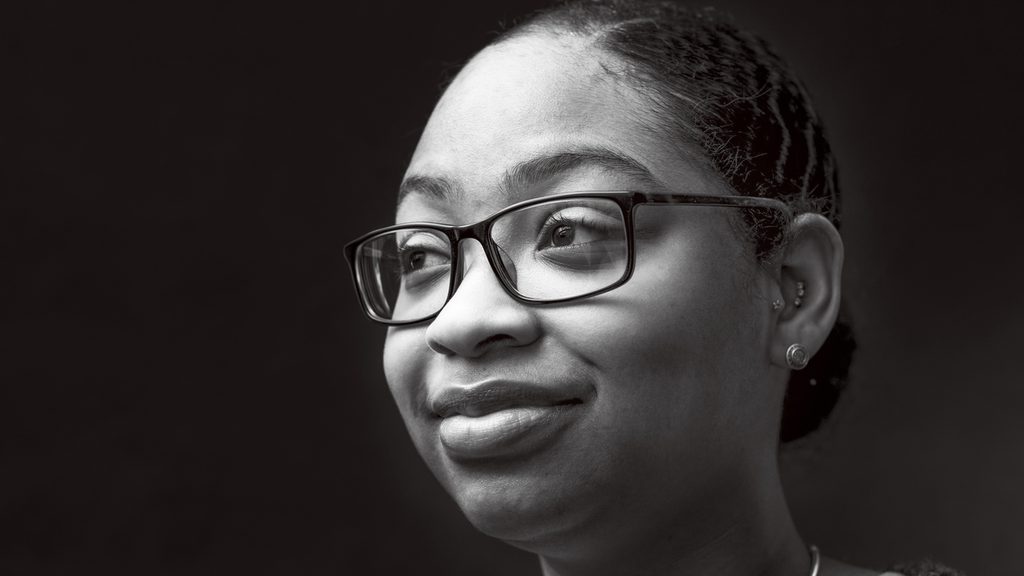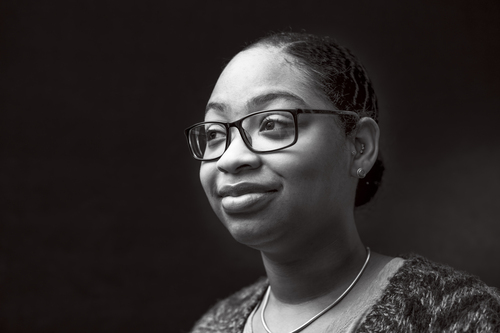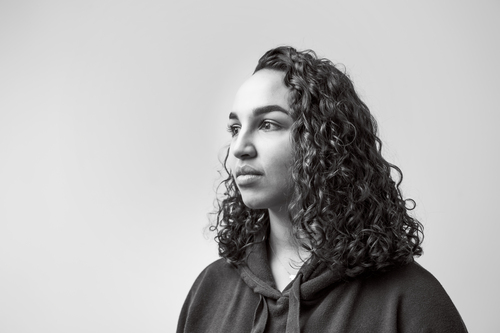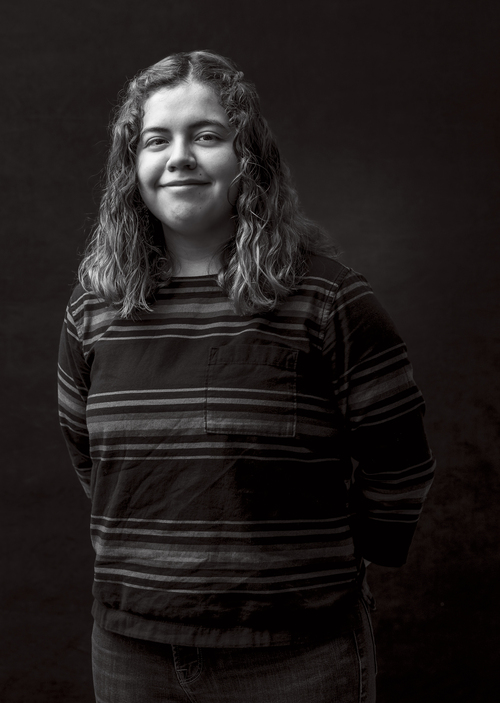
Academia for All
Books like Robert Kiyosaki’s Rich Dad Poor Dad and You Are a Badass at Making Money, by Jen Sincero, pitch themselves as sources of financial literacy for everybody who isn’t a banker or an economist. “But I’m trying to figure out what assumptions are being made in these books, and what’s really not true and misleading,” Lewis says. “And it’s clear that they’re not aimed at all of us.”
Danielle Lewis ’20 is taking a long, hard look at financial self-help books.
Books like Robert Kiyosaki’s Rich Dad Poor Dad and You Are a Badass at Making Money, by Jen Sincero, pitch themselves as sources of financial literacy for everybody who isn’t a banker or an economist. “But I’m trying to figure out what assumptions are being made in these books, and what’s really not true and misleading,” Lewis says. “And it’s clear that they’re not aimed at all of us.”
Impoverished people of color and others who live in marginalized communities aren’t likely to have a “rich dad” father figure to imitate, says Lewis, who is majoring in sociology and anthropology. The “101 Real Money Questions” answered in a book of the same name by Jesse B. Brown were submitted to him by mostly middle-class African Americans.

Lewis’s assumption-probing research project is the centerpiece of her Mellon Mays Undergraduate Fellowship (MMUF), which she holds thanks to a three-decades-old program of the Andrew Mellon Foundation aimed at encouraging undergraduate students who belong to minority groups—and nonminority students who show that they’re committed to diversity—to pursue PhDs in the humanities and social sciences and become professors in those disciplines.
The fellowship supplies financial and intellectual support for an original research project intended to give students a taste of professional scholarship. Along the way, fellows learn what graduate school and faculty life will both offer and ask of them. Prospective fellows apply in their sophomore year, around the time they declare their majors, then work with a faculty mentor on their project as juniors and seniors. After that, Mellon mentorship and support continue in multiple ways, through graduate school and into fellows’ early careers as teachers and scholars.
For her part, Lewis, a Chicagoan, is ultimately headed to graduate school in sociology. “My goal is to attack these dominant narratives that we have around certain things like financial literacy, race, and whiteness,” she says. “I want to dissect all those nuances.”
Lance McCready ’90, Associate Professor of Leadership, Higher and Adult Education, University of Toronto, “What the Mellon Meant to Me”
With an MA and a PhD in social and cultural studies in education from the University of California–Berkeley, McCready focuses on the education, health, and well-being of urban youth, with an emphasis on gay and gender-nonconforming black male students.
“Receiving the Mellon Mays Fellowship validated my aspirations to be a professor. It also created a cohort of faculty who supported my professional goals and a cohort of students of color with similar aspirations, despite the fact that we were underrepresented in academia and may have been the first in our families to dream about the possibilities of a career in it. Mellon Mays alumni tend to have a strong commitment to transforming the professoriate by mentoring and supporting Mellon Mays scholars who are at the beginning of their journey.”
Addressing a Disparity
The Mellon fellowship program was established to address the fact that as the student populations of American universities were becoming more and more diverse in the 1970s and ’80s, the professoriate—particularly in the humanities and social sciences—remained much less so.
Carleton was in on the ground floor of the program; the college was one of the eight institutions that launched it in the 1988–89 academic year, along with Bryn Mawr, Cornell, Hunter, Oberlin, Swarthmore, and the Universities of Chicago and Pennsylvania. Today, 45 U.S. schools belong—including Harvard, Yale, Columbia, and Stanford—along with three South African universities and three consortia, the largest of which is the UNCF group of historically black colleges and universities.
To date, more than 5,000 students have been selected as fellows, and more than 800 of them have earned a PhD. The majority of the Mellon fellows who have completed their doctorates have held an appointment in the academy or currently hold one; more than 120 of these scholars are tenured.
A Carleton Confab
In November 2019—MMUF’s 30th-anniversary year— Carleton hosted the program’s Midwest Regional Conference, welcoming 50 fellows from Macalester, Northwestern, Oberlin, Grinnell, Washington University, and the University of Chicago, along with faculty members from those schools. In four rooms in the Weitz Center, the fellows, including Lewis, presented papers and research reports on their Mellon projects in a scenario intended to prepare them for academic conferences like the annual conventions of the Modern Language Association and the American Sociological Association.

Topics ranged from explorations of minority identity and self-image to assessments of the legacy of racism and colonialism to analyses of music and film—and well beyond. Sogra Nassri ’20, a political science major from Denver, focused on the moral aspects of marijuana prohibition and legalization, and sociology and anthropology major and Omaha native Justis Starks ’20 presented on the experience of biracial Americans. Jorge Bañuelos Jr. ’20, who is working toward a double major in history and religion and a minor in Africana studies, examined the concept of blackness in the writings of the African American theologian James H. Cone and the Martiniquais psychiatrist-philosopher Frantz Fanon.

Bañuelos, from Wichita, Kansas, is clear on the importance of bringing the perspectives of young scholars of color to bear upon the issues with which academia grapples. “For a long time, the white male gaze has been dominant in scholarship,” he says. “White maleness has been the standard of objectivity. Having a more diverse body of college and university professors means being able to refocus the questions that animate scholarly study, and refocus on what it’s like to be someone who studies those questions, too.”
Religion professor Lori Pearson, the David and Marian Adams Bryn-Jones Distinguished Teaching Professor of the Humanities, who coordinates the program at Carleton, says the MMUF aligns with the college’s values.
“Carleton’s mission is to provide a liberal arts education of the highest quality,” she says. “But I think we have a distinctive way of understanding that phrase, ‘highest quality.’ It has to do with exploring questions that really matter and, in that way, helping students develop a meaningful philosophy of life. An important part of that process is challenging all students to see, understand, and study the diversity of our world.
“Mellon encourages students to pursue research projects that ask questions that have been underexplored in the canon and in the different disciplines, because ‘authoritative’ knowledge has often focused on dominant groups, on people perceived as the dominant actors, on certain historical communities perceived as ‘worth studying.’ ”
History professor William North, who served previously as the MMUF’s faculty coordinator, says that fellows often choose topics that are “rooted in part of their personal history. They’re not comfortable with the idea of researching something that is simply a matter of curiosity. They want to make an impact.”
Creating a Community

Fellows-to-be typically first hear about the MMUF through informal channels. For example, Spanish and Latin American studies double major Claudia Hernández Barrientos ’21, from Houston, learned about the program when she was a sophomore from two seniors who were fellows. She credits the fellowship with doing for her one of the major tasks it was designed for: demystification. “Before Mellon, I was not a hundred percent sure I would go to grad school,” she says. “I didn’t know much about what was involved. But being in the program, I know a lot more about the process. I know what it takes, and I feel more confident.”
A professor in the sociology and anthropology department tipped off Lewis about Mellon. “She said she thought I would be a good fit for the program and she didn’t want me to pass it up,” says Lewis. “So I looked into it and got more involved with people already in the program.”
Like Hernández, Bañuelos learned about Mellon from friends who were already in the program. “They told me that there was money and support available on campus for people who just wanted to read books and write professionally,” he says. “It was kind of unbelievable to me then that you could actually get paid for doing that kind of work.”
Run through the student fellowships office, the application process asks aspiring fellows to write an essay about their proposed research project and a personal statement that explains how the topic relates to their experiences in education and in life. “The project needs to be broad enough for them to work on for a couple years, but specific enough that we can see that they have a talent for research, for how to ask a question, and how to frame a topic,” says Pearson. “There’s a long process of mentoring students in writing these applications.” A committee made up of faculty members and administrators makes the final selection—typically four or five students per year.
As faculty coordinator, Pearson teaches a year-long research seminar for the fellows. In the fall Pearson focuses on giving students the tools for conducting in-depth research and teaching them about other aspects of scholarly work, like creating research posters and writing abstracts for papers they intend to submit to scholarly journals. Her main goal is to prepare them to present preliminary papers on their topics at the annual autumn regional conference, which rotates around the midwestern Mellon campuses. The fellows workshop their presentations and their PowerPoints, and get feedback from Pearson and one another.
“In the winter seminar, we focus on creating a community and having vibrant intellectual conversations among the fellows,” says Pearson. “They more or less co-teach: assign reading and share their research interests with the group in a way that invites everyone into the conversation. So, for example, two fellows might work together on a presentation on the politics of defining blackness because they both are working on topics around African American racial identity.”
In spring the seminar shifts back to the research tools they’ll need to engage in the summer-long research that will culminate in their final paper.
The sense of community that develops in the Mellon cohort is one of Anthony Harb’s favorite aspects of the program. A fellow who is now in a PhD program at the City University of New York (CUNY) Graduate Center and teaching at CUNY’s Medgar Evers and Brooklyn College campuses, Harb ’15 says of his experience: “The warmth of Carleton as a community helped us develop close relationships pretty easily. And the regional conferences were great, because we got to meet people from all over the Midwest. There’s an energy, a culture that’s created by past Mellons, by the current Mellons, and by post-Mellons. It’s like you’re a part of Mellon forever.”-
Mentors Matter

Another keystone of the MMUF, the faculty mentorship, was crucial for Harb. He asked senior lecturer Beatriz Pariente-Beltrán of the Spanish department to fill that role for him. “I felt comfortable being vulnerable with her,” he says. “I remember going into her office and saying, ‘Listen, Beatriz, I am a first-generation, low-income college student. I don’t know anybody with a PhD except for the professors around me. I don’t know what that process looks like. I’m interested in research. I’m interested in education. I would like to be a professor, and I’m looking for guidance on that process.’”
Harb and Pariente-Beltrán set up monthly meetings with goals for Harb’s research project, which centered on the processes of learning a language. Specifically, Harb looked at the social factors that come into play when someone who grows up around highly idiomatic Puerto Rican or Mexican Spanish is confronted by the very different Spanish taught in the American educational system. A Palestinian American, Harb was drawn to the topic by the gulf between the Arabic he knew at home in Chicago and the Arabic taught at Carleton.
He shared his insecurities with Pariente-Beltrán as well as his progress. “Sometimes I would come into her office and say, ‘Okay, I have no idea what I’ve been doing for this past month because I don’t know how this works. I’m reading a lot, but is that research? I haven’t written anything—is that okay?’ And she guided me step by step to really understanding what a research project might look like.”
Hernández found it easy to find a mentor who shared her research interests. One of her first classes at Carleton was with Spanish professor Palma Álvarez-Blanco. “For the class, I did a civic engagement project with the Latino community in Northfield,” she says. “I met community members and people who are involved with the Latinos Unidos organization here and got interested in the community. When the Mellon opportunity came, I knew what I wanted to research, and I knew that I would ask Palma to be my mentor. She gave me lots of ideas and directions to pursue.”
When Lewis’s project hit the wall and she had to alter it, her faculty mentor, Annette Nierobisz in the sociology and anthropology department, helped her stay the course. “I had to learn how to take things in stride,” Lewis says. “Things don’t necessarily work out. I learned how to be involved with long-term research projects that aren’t linear in how they develop.”
“Interdisciplinary, Intermeshed, Interconnected”
Although the fellows select a single official mentor, it’s typical for them to connect with other faculty members as well, often in different disciplines. In fact, the interdisciplinary approach is natural for many of the fellows’ research topics, particularly those in which the issue of race plays a key role. Lewis’s simultaneous examination of financial literacy, race, and the assumptions rooted in whiteness is one example. In Sogra Nassri’s study of marijuana legalization, analysis of shifting public opinion and political positioning is combined with awareness of how intensely racialized the prohibition of marijuana has been.
“I think that the problems we face in the world are just inherently interdisciplinary, intermeshed, interconnected,” says Bañuelos. He points to the scholarship and advocacy of UCLA/Columbia University law professor Kimberlé Crenshaw, who developed the theory of intersectionality—how a person’s multiple social and political identities (for example, gender, race, class, sexuality, ability, etc.) might combine to create unique modes of consciousness in that person—and unique modes of discrimination against them too
“Interdisciplinarity has been central to my research, which I do in the intersections between linguistic anthropology, sociolinguistics, media studies, and Latino studies,” says Harb. “Given that academia has not traditionally belonged to people of color, interdisciplinarity gives us the ability to pave our own way. It gives us the freedom to create new boxes or no boxes at all, to create new intellectual ways of being that are in line with new ways of being in academia in general.”
Making Connections—and Change
Five years after graduating from Carleton, Harb says the Mellon community is a continuing asset. “At CUNY and at Brooklyn College, there are so many people who did Mellon in different parts of the country. We all see how important and formative and beneficial our Mellon connections are for the collective of professors and researchers of color.”
That developing collective is crucial, he continues, not just for making academia more representative of America, but also for furthering the transformation of academia, which has often been complicit with the American power structure and its worldview.
“As we move closer to understanding the complexities that make up the world—social relationships, inequalities, failures and successes—all voices are necessary both within and outside of academia,” Harb says. “I think young people of color, for example, have productive sensibilities that can bridge the gaps between academia and the streets.
“All of us are little pieces in a slow but revolutionary process that’s happening right now.”